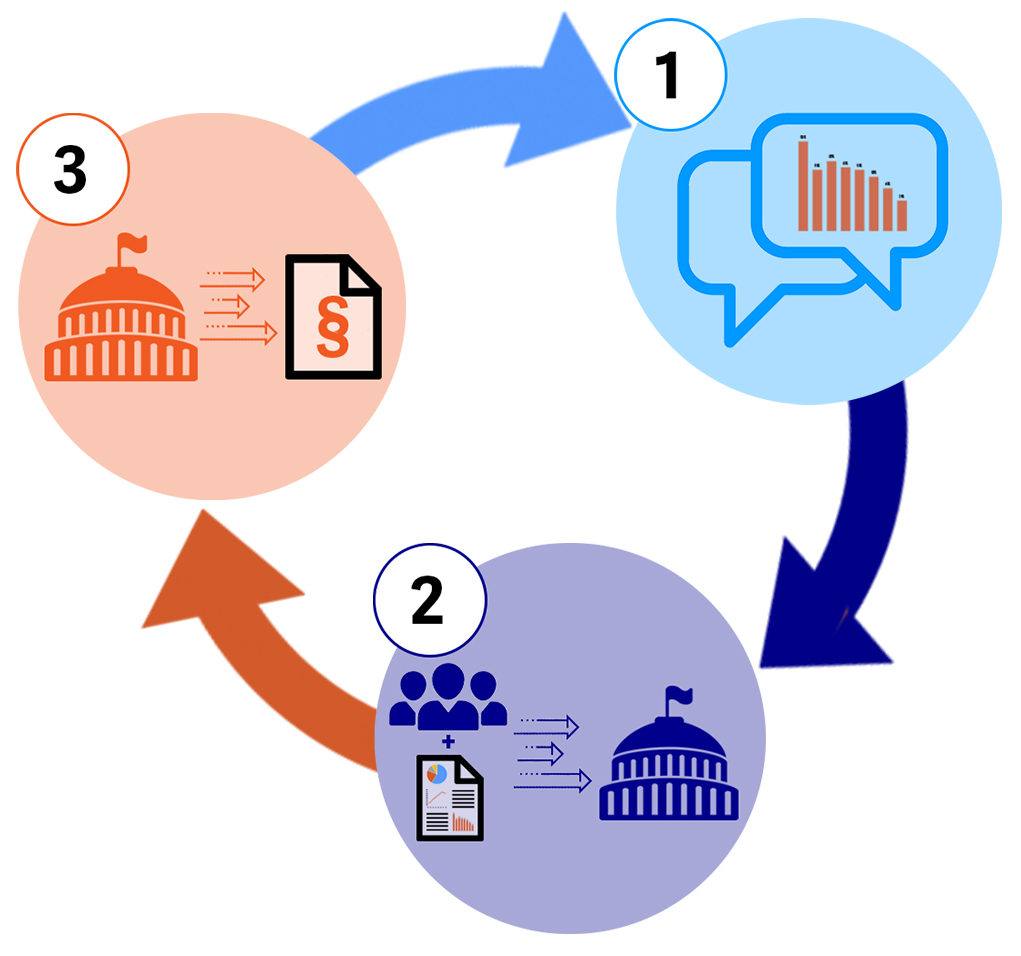Part 3, Strategy 4
Action Item 3: Educate stakeholders, policymakers, and the public to maintain momentum.
Why it matters
Communicating results is critical to maintaining momentum for criminal justice policy changes and ensuring that these efforts remain collaborative and transparent. If states do not have a strategy in place for sharing information and receiving input from key stakeholders, such as county leaders, victims, and law enforcement officers, they run the risk of losing support from the public and key criminal justice stakeholders, allowing for the rollback of changes, or missing valuable feedback needed to implement policies effectively.
What it looks like
- Create user-friendly data reports to make information available and accessible to criminal justice system stakeholders.
- See Case Study: States create data dashboards
- Develop an outreach strategy to engage and educate stakeholders and the public on progress and outcomes of reforms.
- See Case Study: States connect with stakeholders about implementation progress
- Adjust statute, policy, or implementation strategy based on data and stakeholder feedback, as necessary.
- See Case Study: States refine policies based on data
Key questions to guide action
- How are performance and outcome data on reforms currently shared with criminal justice stakeholders and the public?
- Has the state invested in the development of a data dashboard or issued publications to regularly share performance data with the public?
- Does the state have a strategy in place to inform and engage the public on reform efforts and gather feedback?
Use the information that follows to inform your answers to these questions.
States must communicate results to the public to maintain transparency and momentum for policy changes and gather input from the community to inform future policymaking.

Case Study
States create data dashboards
A growing trend across states is the creation of public dashboards or online databases to disseminate information about policy measures and outcomes.
- The Kansas Department of Corrections has an online dashboard presenting annual prison and community corrections measures and metrics.
- Oregon’s Criminal Justice Commission implemented an interactive data dashboard of criminal justice trends in the state, incorporating Justice Reinvestment and other criminal justice measures and metrics into a publicly available website. This comprehensive approach is being explored by other states, including California and Georgia.
- The Pennsylvania Commission on Crime and Delinquency created an interactive online database in partnership with the state’s correctional agencies that allows the public to access monthly and annual performance measures that track the legislation’s outcomes, including prison population, admissions and releases, reinvestment of savings, crime trends, and recidivism rates.
Case Study
States connect with stakeholders about implementation progress
Some states have formed subcommittees to develop statewide outreach and education strategies targeted to system stakeholders and the public and deliver presentations on Justice Reinvestment implementation progress and outcomes at association conferences and other public events. States have also organized forums and conferences to bring together policymakers, agency leaders and staff, and other criminal justice stakeholders to discuss progress and strategies for sustaining reforms.
- In Georgia, the Department of Community Supervision engages in semi-annual efforts to reach out to judges and prosecuting attorneys to inform them of Justice Reinvestment policy changes and outcomes.
- In 2013, the Kansas Sentencing Commission and Department of Corrections held regional events to meet with probation officers, law enforcement officers, judges, and other criminal justice stakeholders to inform them of the Justice Reinvestment policy changes.
- In 2014, North Carolina legislators held a half-day hearing with probation officers to hear their input on policy implementation and recognize their efforts to put new violation response practices into place effectively.
- In 2016, Oregon began holding an annual Justice Reinvestment Summit to bring together state leaders to discuss results, share ideas, and update the legislature on progress. The summit also gave Governor Kate Brown a platform to express her support and promote the state’s ongoing reform work in 2017.
Case Study
States refine policies based on data
Sometimes legislation is enacted that contains unclear language or omissions, or unintended results unfold upon implementation. States may need to enact further legislation to address deficiencies in the original bill or adjust agency policies based on feedback from system stakeholders and agency staff to achieve intended results.
- In 2015, Nebraska’s chair of the Legislative Committee on Justice Reinvestment Oversight and Senate Judiciary Committee asked the public to give his office feedback on confusing legislative language and other technical corrections to the legislative language. A working group of county attorneys, defense attorneys, judges, and other system stakeholders reviewed the feedback and advised how to adjust statutory language through a consensus-based process. Legislation reflecting the feedback was enacted in 2016.
- In 2014, following the implementation of new violation response policies, the Pennsylvania Department of Corrections and Board of Probation and Parole (PBPP) found that parole agents were frequently recommending revocations to prison for violations rather than using intermediate sanctions, such as assigning people to technical parole violator centers. After reviewing the data with parole agents and gathering their input on factors contributing to the trend, the PBPP adopted a revised policy in 2015 requiring parole agents to send people to technical violator centers before recommending revocations to prison. As a result, the number of people being held in prisons for technical violations of the conditions of parole fell approximately 70 percent between January 2014 and December 2015.
